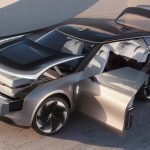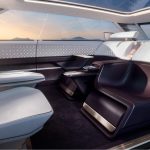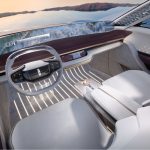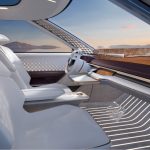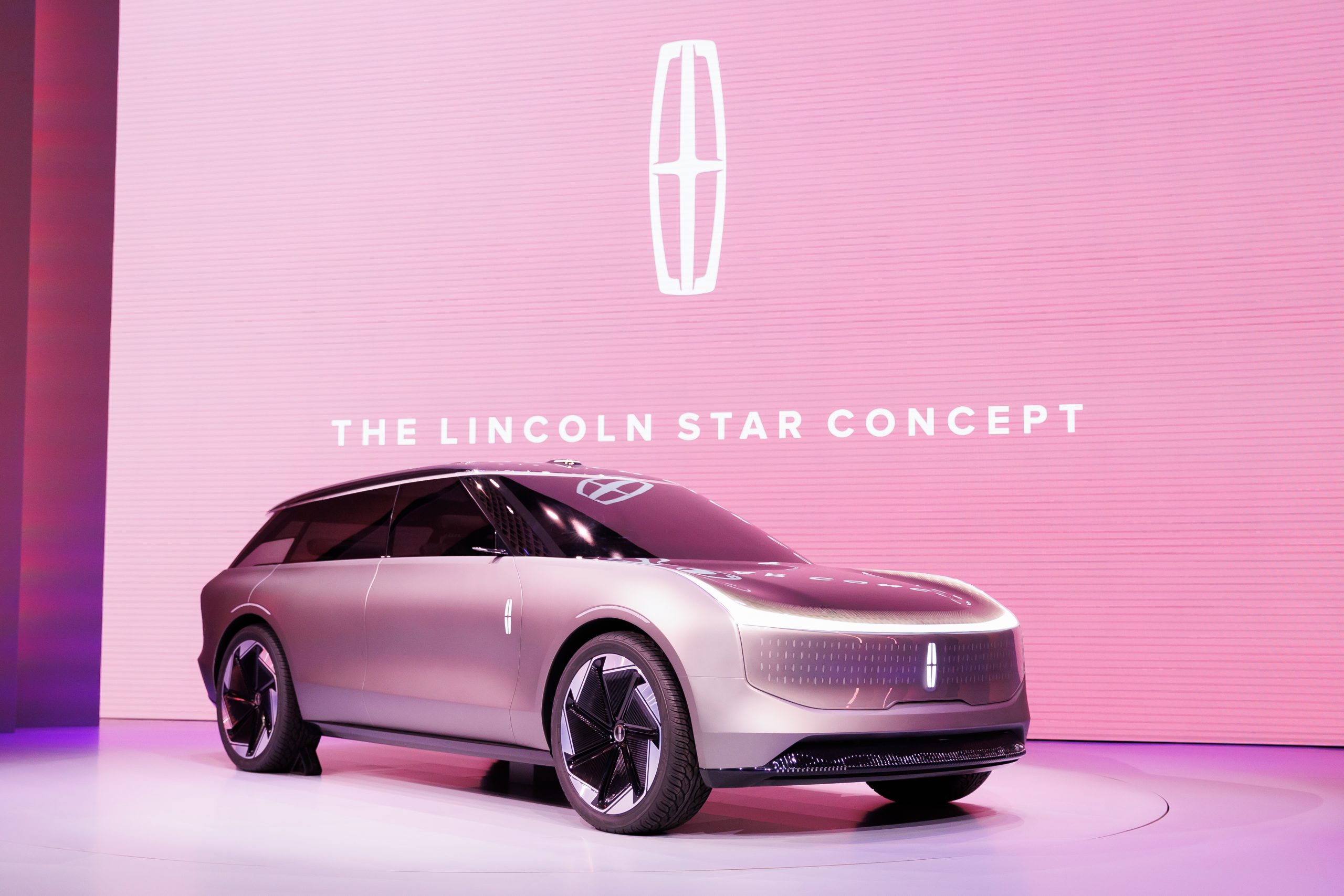
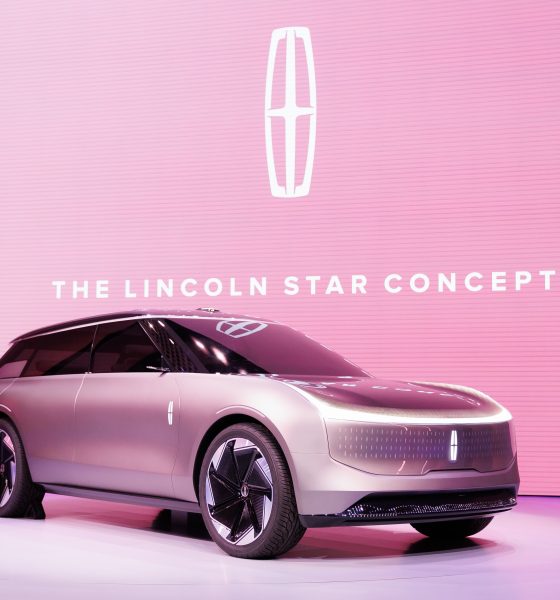
News
Lincoln unveils Star Concept EV with plans for three fully electric vehicles by 2025
Lincoln unveiled its Star Concept EV earlier this week to showcase its “captivating, dynamic new face – revealing the brand’s vision for connected, electrified vehicles.” The Star Concept EV, which officially debuted on Wednesday, brings fresh design ideas and concepts to Lincoln’s brand language, which prepares to partially transition to electric powertrains with three full EVs by 2025.
“This is a shining example of what happens when we combine Lincoln luxury with flexible electrical architecture to create unimaginable experiences for customers,” Ford CEO Jim Farley said. “We can truly revolutionize how people engage with the brand and scale it across an exciting lineup of products that catapult Lincoln into the digital, connected age.”
Despite its futuristic design, the Star Concept encapsulates a new design language with Lincoln’s tenets of beauty, human, gliding, and sanctuary on full display. These design tenets will help Lincoln navigate a tough transition to EVs, as it plans to have three models powered by electric powertrains by 2025. An additional model is expected the following year.
Rivian's partnership with Ford will bring Lincoln its first luxury electric vehicle
“As Lincoln enters the next chapter in our transition to a zero-emissions future, the Lincoln Star Concept will lead the way for our portfolio of fully electric vehicles,” Lincoln President Joy Falotico said. “It is an excellent example of how we are redefining luxury for the next generation as we work to transform the vehicle into a third space – a true place of sanctuary – for our clients.”
How the Star Concept will lead Lincoln’s EV Efforts
The Lincoln Star Concept EV delivers modern aesthetics with intelligent features, but the company truly planned to make the vehicle “the ultimate sanctuary for clients.”
“Electrification is removing many traditional vehicle design constraints, allowing us to reimagine what a vehicle can be,” Chief Design Officer for Ford Motor Company Anthony Lo said. “The Lincoln Star is a study of experiences and themes that push the boundaries of Lincoln design – and it’s just the start.”
- Lincoln Concept vehicle. Not available for purchase.
- Lincoln Concept vehicle. Not available for purchase.
A hat-tip to Lincon’s evolving design language, the new Star Concept EV combines sleek and dynamic silhouette features with an immersive experience that is truly one-of-a-kind. Lincoln said that the vehicle, “whether stationary or in motion, the concept uses design, light, displays, scents, and sounds to create an immersive experience for clients. Intelligent technology that enhances comfort, productivity, and entertainment is deployed throughout to bring the romance of travel back in a uniquely Lincoln way.”
Electric vehicles in today’s market are more like smartphones than like automobiles, in a way. Lincoln highlights its focus on an intelligence system to capture the essence of a “digital assistant.” These assistive techniques and ideas for a more in-depth ownership experience will enable features like “connected vehicle-to-vehicle and infrastructure capabilities, as well as next-generation leading driver-assist features such as Help Me See and Park for Me,” Lincoln said.
A Sanctuary Vehicle
An increased focus on luxurious feel and comfort was obviously dialed in by Lincoln before releasing images of the Star Concept EV. The interior is partitioned into first and second-row areas, with premium, spacious, wraparound seating that offers comfortable reclined lounge posture and individual leg rests, providing a truly unmatched interior experience only seen in the most premium luxury vehicles. Horizontal display screens seamlessly integrated into the vehicle’s interior provide a unique and modern experience.
- Lincoln Concept vehicle. Not available for purchase.
- Lincoln Concept vehicle. Not available for purchase.
- Lincoln Concept vehicle. Not available for purchase.
Lincoln is also introducing “rejuvenation moods:”
“Three rejuvenation moods join a new Lincoln Embrace sequence harmonizing audio, scenting and lighting throughout the cabin. A symphonic orchestration with crisp, high-resolution animations on the displays creates an immersive digital sanctuary. Whether stuck in traffic or just enjoying a few quiet moments after work, the rejuvenation moods provide a true sanctuary in a third space:
- Coastal Morning uses gentle, oceanic sounds, a fragrance of sea mist and the soft, warm glow of the sun with dynamic lighting throughout to replicate a stroll on the beach at sunrise
- Mindful Vitality is meant to reenergize the senses, with invigorating, upbeat audio, dynamic abstract artwork, soft, glowing lighting and a flowery fragrance throughout
- Evening Chill mirrors dusk using a calming night soundtrack coordinated with night sky video and an evergreen fragrance”
“The Lincoln Star Concept has been a true labor of love for our team and provides us with a platform to share and test our experiences and design philosophy with clients as we evolve our Quiet Flight DNA,” Kemal Curic, Lincoln’s Global Design Director, said. “Signifying transcendence through both space and time, the concept creates a sense of peace and serenity within an electric experience and previews what is to come from Lincoln.”
I’d love to hear from you! If you have any comments, concerns, or questions, please email me at joey@teslarati.com. You can also reach me on Twitter @KlenderJoey, or if you have news tips, you can email us at tips@teslarati.com.

Elon Musk
Elon Musk and Tesla AI Director share insights after empty driver seat Robotaxi rides
The executives’ unoccupied tests hint at the rapid progress of Tesla’s unsupervised Robotaxi efforts.

Tesla CEO Elon Musk and AI Director Ashok Elluswamy celebrated Christmas Eve by sharing personal experiences with Robotaxi vehicles that had no safety monitor or occupant in the driver’s seat. Musk described the system’s “perfect driving” around Austin, while Elluswamy posted video from the back seat, calling it “an amazing experience.”
The executives’ unoccupied tests hint at the rapid progress of Tesla’s unsupervised Robotaxi efforts.
Elon and Ashok’s firsthand Robotaxi insights
Prior to Musk and the Tesla AI Director’s posts, sightings of unmanned Teslas navigating public roads were widely shared on social media. One such vehicle was spotted in Austin, Texas, which Elon Musk acknowleged by stating that “Testing is underway with no occupants in the car.”
Based on his Christmas Eve post, Musk seemed to have tested an unmanned Tesla himself. “A Tesla with no safety monitor in the car and me sitting in the passenger seat took me all around Austin on Sunday with perfect driving,” Musk wrote in his post.
Elluswamy responded with a 2-minute video showing himself in the rear of an unmanned Tesla. The video featured the vehicle’s empty front seats, as well as its smooth handling through real-world traffic. He captioned his video with the words, “It’s an amazing experience!”
Towards Unsupervised operations
During an xAI Hackathon earlier this month, Elon Musk mentioned that Tesla owed be removing Safety Monitors from its Robotaxis in Austin in just three weeks. “Unsupervised is pretty much solved at this point. So there will be Tesla Robotaxis operating in Austin with no one in them. Not even anyone in the passenger seat in about three weeks,” he said. Musk echoed similar estimates at the 2025 Annual Shareholder Meeting and the Q3 2025 earnings call.
Considering the insights that were posted Musk and Elluswamy, it does appear that Tesla is working hard towards operating its Robotaxis with no safety monitors. This is quite impressive considering that the service was launched just earlier this year.
Elon Musk
Starlink passes 9 million active customers just weeks after hitting 8 million
The milestone highlights the accelerating growth of Starlink, which has now been adding over 20,000 new users per day.

SpaceX’s Starlink satellite internet service has continued its rapid global expansion, surpassing 9 million active customers just weeks after crossing the 8 million mark.
The milestone highlights the accelerating growth of Starlink, which has now been adding over 20,000 new users per day.
9 million customers
In a post on X, SpaceX stated that Starlink now serves over 9 million active users across 155 countries, territories, and markets. The company reached 8 million customers in early November, meaning it added roughly 1 million subscribers in under seven weeks, or about 21,275 new users on average per day.
“Starlink is connecting more than 9M active customers with high-speed internet across 155 countries, territories, and many other markets,” Starlink wrote in a post on its official X account. SpaceX President Gwynne Shotwell also celebrated the milestone on X. “A huge thank you to all of our customers and congrats to the Starlink team for such an incredible product,” she wrote.
That growth rate reflects both rising demand for broadband in underserved regions and Starlink’s expanding satellite constellation, which now includes more than 9,000 low-Earth-orbit satellites designed to deliver high-speed, low-latency internet worldwide.
Starlink’s momentum
Starlink’s momentum has been building up. SpaceX reported 4.6 million Starlink customers in December 2024, followed by 7 million by August 2025, and 8 million customers in November. Independent data also suggests Starlink usage is rising sharply, with Cloudflare reporting that global web traffic from Starlink users more than doubled in 2025, as noted in an Insider report.
Starlink’s momentum is increasingly tied to SpaceX’s broader financial outlook. Elon Musk has said the satellite network is “by far” the company’s largest revenue driver, and reports suggest SpaceX may be positioning itself for an initial public offering as soon as next year, with valuations estimated as high as $1.5 trillion. Musk has also suggested in the past that Starlink could have its own IPO in the future.
News
NVIDIA Director of Robotics: Tesla FSD v14 is the first AI to pass the “Physical Turing Test”
After testing FSD v14, Fan stated that his experience with FSD felt magical at first, but it soon started to feel like a routine.

NVIDIA Director of Robotics Jim Fan has praised Tesla’s Full Self-Driving (Supervised) v14 as the first AI to pass what he described as a “Physical Turing Test.”
After testing FSD v14, Fan stated that his experience with FSD felt magical at first, but it soon started to feel like a routine. And just like smartphones today, removing it now would “actively hurt.”
Jim Fan’s hands-on FSD v14 impressions
Fan, a leading researcher in embodied AI who is currently solving Physical AI at NVIDIA and spearheading the company’s Project GR00T initiative, noted that he actually was late to the Tesla game. He was, however, one of the first to try out FSD v14.
“I was very late to own a Tesla but among the earliest to try out FSD v14. It’s perhaps the first time I experience an AI that passes the Physical Turing Test: after a long day at work, you press a button, lay back, and couldn’t tell if a neural net or a human drove you home,” Fan wrote in a post on X.
Fan added: “Despite knowing exactly how robot learning works, I still find it magical watching the steering wheel turn by itself. First it feels surreal, next it becomes routine. Then, like the smartphone, taking it away actively hurts. This is how humanity gets rewired and glued to god-like technologies.”
The Physical Turing Test
The original Turing Test was conceived by Alan Turing in 1950, and it was aimed at determining if a machine could exhibit behavior that is equivalent to or indistinguishable from a human. By focusing on text-based conversations, the original Turing Test set a high bar for natural language processing and machine learning.
This test has been passed by today’s large language models. However, the capability to converse in a humanlike manner is a completely different challenge from performing real-world problem-solving or physical interactions. Thus, Fan introduced the Physical Turing Test, which challenges AI systems to demonstrate intelligence through physical actions.
Based on Fan’s comments, Tesla has demonstrated these intelligent physical actions with FSD v14. Elon Musk agreed with the NVIDIA executive, stating in a post on X that with FSD v14, “you can sense the sentience maturing.” Musk also praised Tesla AI, calling it the best “real-world AI” today.
